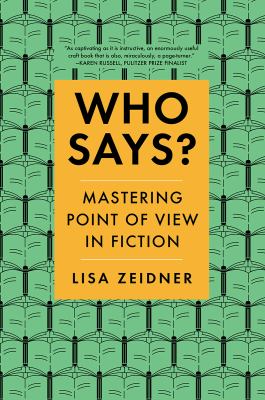When it comes to point-of-view work, my enduring favourite is Ursula K. LeGuin’s Steering the Craft, but she takes only a few pages to cover the topic; Lisa Zeidner’s booklength treatment is warranted. As a key aspect of characterization, the questions raised and explored here could vault your creative work from competent to self-assured.
The emphasis is on the exploring, however; Zeidner presents and discusses examples more than she directs. This requires a substantial commitment; readers (writers) must actively participate in her process. It’s not until the very end of the book, for instance, that there are any exercises or instruction sets.
Writers who prefer a checklist approach might be frustrated by this immersion approach, and beginners who have not read widely might be overwhelmed by the number of quotations and references to accomplished writers’ novels and stories. And, like Stephen King’s On Writing, the book concludes with an awesome bibliography, which could serve as a reading list.
Experienced writers, however, might long for some references to genre works (The Handmaid’s Tale by Margaret Atwood and Shirley Jackson’s famous story—these are as close as she gets) and more unconventional selections (although it’s refreshing to see Percival Everett and Kevin Kwan and there are some 2019 works, including a New Yorker story—you can probably guess which one).
Zeidner’s clarity and cohesion are remarkable, however. One of her basic premises is that readers can dislike/mistrust the characters but must like/trust their author; with that, the focus shifts to how to build and maintain the trust between reader and author. Content-wise, this is a valid position; Zeidner takes it one step further and chooses illustrative and pertinent extracts to build trust with her readers too.
She also holds that questions of authenticity and appropriation are largely point-of-view questions; it’s a simple and sensible statement that opens up possibilities for problem-solving and revision. She stands at the edge of the culture wars, surveys the battlefield, and encourages readers to explore that concept independently.
It’s useful to understand that many aspects of storytelling which appear to be trends in the present-day can be studied in a historical context. For example, she does discuss Gone Girl’s unreliable narration (a predictable but recognizable example), but she also traces the pattern back to Lawrence Sterne and through Mark Twain, to explain that it’s not new to question a narrator’s objectivity.
Her style feels proper though not formal, and occasionally she slips in a cozier way of talking (like describing an excerpt in the first person as being a pull-up-a-chair style) and she made me laugh with this: “DFW is so famous that his initials alone are enough to identify him, as if he’s an airport. Once you’re that influential as a writer, your tones and trends are just in the air, like the flu.”
Beyond the expected chapter headings, she also considers Childhood and Animal perspectives and there is a chapter on “Thinking Like a Camera” about Point of View in Fiction Versus Film. The content is on-topic but still relevant, so that even if none of those situations applies to your own work, these chapters are still interesting in the broader context of crafting.
When it comes to universal advice—the kind of truisms you expect to find in books about writing—I like the way she expresses herself: “In order to write, you have to believe that no matter how many other books are on your shelf, the story you tell is yours and yours alone.”
When it comes to specific suggestions, with concrete application, I find them sparky and practical: “Each new match the character strikes leaves the character and the reader in a meaningless cloud of smoke.” This is how she describes the sensation of a first-draft or unpolished scene in dialogue, punctuated with gestures that do not relate to the characters, only feel like filler. Later, in the Exercises section, one of the suggestions is as follows: “Find a cliched stage direction in your story—a raised eyebrow or hands on hips—and try to find a gesture that is actually revealing about the character.”
Although not a volume I’d expect to revisit frequently, Zeidner’s Who Says? provides a detailed and informed examination of a topic that deserves more consideration.
Very good stuff for writers.
Lisa Zeidner. Who Says? Mastering Point of View in Fiction. New York: W.W. Norton & Company, 2021.

